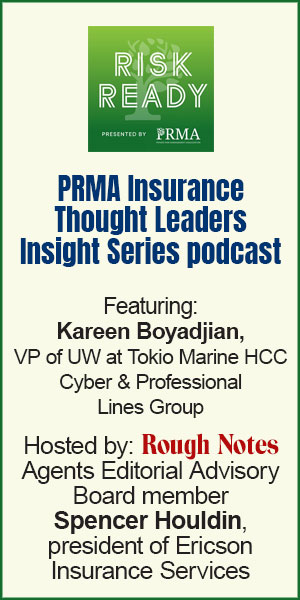 A lesson in insurance quote comparisons
A lesson in insurance quote comparisons
Whether it’s to catch mistakes, find oversights, or discover
carrier limitations, it’s critical that new producers learn to check quotes … .
By Marc McNulty, CIC, CRM
Many years ago, when I first entered the insurance industry, I was slightly shocked to learn that I needed to check the work of those who we rely on—namely underwriters for those of us in the independent agency space. Yes, I’d had to show my own work throughout high school and college, but I was never told that once I entered the real world, I’d need to check the work of others!
I suppose I assumed I was dealing with professionals who rarely made mistakes, so the concept initially seemed unnecessary to me. However, once I got past my naiveté and learned that checking quotes was done for good reason, I quickly discovered something else I had not been told during my pre-licensing coursework: Not all insurance quotes are created equal.
Whether it’s to catch mistakes, find oversights, or discover carrier limitations, it’s critical that new producers learn to check quotes received from underwriters against what was asked for on your submitted applications.
I recently took aside our agency’s newest producer, who had just recently punctuated his college career by earning his MBA, and illustrated the importance of this concept to him. His insurance experience to date had been limited to personal lines quotes, a few BOPs, and some professional liability policies in a niche area our agency writes. Identifying the subtle—and not-so subtle—differences between commercial package quotes was undoubtedly an eye-opening exercise, especially when there was a 23% price difference between two of the quotes on a new business package I was attempting to write.
He soon learned the initial importance of this when I pulled up our property ACORD applications and showed him how two carriers had quoted the requested coverage. (Side note: I received three quotes on the account, a declination, and no response from a fifth carrier. My goal was to illustrate key differences between the two quotes with the largest coverage and premium differences).
As we dove into things, he saw that Carrier A quoted the building and business personal property at 100% coinsurance with agreed value, which is what I had requested, whereas Carrier B quoted at 80% coinsurance and with no agreed value. As a refresher, getting agreed value on property coverage is extremely important, as it eliminates potential coinsurance issues at the time of a loss, since the client and the carrier agree that the limit(s) of insurance are adequate.
Then we looked at the property deductibles. Both carriers listed $10,000 deductibles, which matched my applications, but Carrier B also included a separate $25,000 Wind/Hail deductible. Immediately following the deductibles on the carrier quotes were the following additional provisions:
Carrier A
Cosmetic Exclusion – Roofs: No
Cosmetic Exclusion – Siding: No
Carrier B
Wind/Hail Cosmetic Damage Roof
Surfacing Excluded
Obviously, this is a huge difference, since Carrier B not only has a $25,000 wind/hail deductible, but they would apply a cosmetic damage exclusion for wind/hail losses! Our young producer was quickly beginning to see where I was going with this exercise, as there were already several key coverage concerns that might not be enough to justify the lower premium.

But there was more.
As requested, Carrier A had quoted business income and extra expense on an actual loss sustained (ALS) basis. As another refresher, this is often preferred, since the insured won’t have to worry about coinsurance issues or monthly limitations after a covered loss. Carrier B had reached out to me on this coverage and the underwriter advised that they didn’t offer ALS coverage on this class of business (it’s a manufacturing account), but we could choose whatever limit of insurance we wanted.
I wasn’t thrilled with this at all but had provided the Carrier B underwriter a limit to use for quoting purposes. My producer understood why I wasn’t happy with this option, however, as the insured doesn’t have a crystal ball telling him how quickly he can get back up and running after a large loss, especially if his building is severely damaged to the point that a temporary location would need to be identified to keep the operation going.
Next, we moved on to the flood insurance sub-limit that was requested. You guessed it: Carrier A included the $1 million sub-limit listed on the applications; Carrier B didn’t. Honestly, I hadn’t taken the time to reach out to Carrier B to see if that was a company limitation of theirs or oversight, since there were already so many other issues on the quote.
Similarly, I had requested that product recall expense be quoted, knowing full well it could potentially be a limitation with one or more companies. In case you haven’t picked up on the pattern here, this proved to be the same as the other issues: Carrier A included it while Carrier B did not.
While the general liability and inland marine coverages matched up between both options, and both quotes included various carrier-specific property and liability enhancements, I finished my presentation by pointing out how Carrier B left off hired car physical damage on the commercial auto portion of the quote. I’m confident that it was a simple oversight, but it didn’t matter at that point; it was clear that I would not be showing Carrier B in my proposal.
My young producer simply smiled and shook his head at that point, having fully absorbed the lesson and how the differences between the two quotes could make or break my prospect’s operations at the time of a loss, not to mention the trouble our agency could have gotten into if we would have presented Carrier B based solely on price.
While checking quotes can be time consuming and less than exciting for those eager to close the deal on as much business as possible, it’s a worthwhile exercise that is invaluable no matter what stage of their career producers find themselves in.
The author
Marc McNulty, CIC, CRM, is a principal at The Uhl Agency in Dayton, Ohio, and has been with the agency since 2001. He divides his time among sales, marketing, technology and operational duties. You can reach Marc at marcmcnulty@uhlagency.com.




